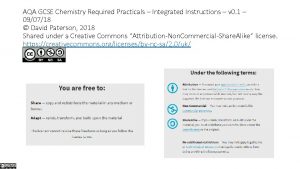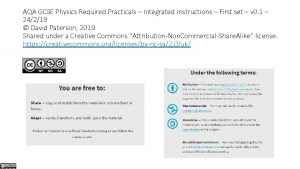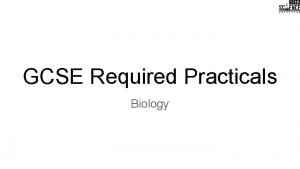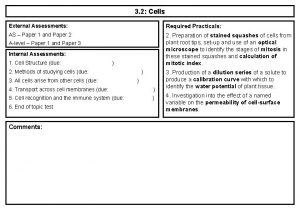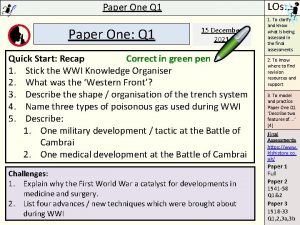Chemistry Required Practicals Paper One Required Practicals Making











- Slides: 11

Chemistry Required Practicals

Paper One Required Practicals

Making Salts Key terms Neutralisation - A chemical reaction of an acid with a base in which a salt and water are formed. If the base is a carbonate or hydrogen carbonate, carbon dioxide is also produced. Filtration - A technique used to separate an insoluble substance in a solvent. Evaporation - A technique used to separate a soluble substance in a solvent. It involves the solvent’s physical change from a liquid phase to a gas phase. Crystallisation - A technique which follows evaporation, in which a solid in a crystalline structure forms. Method and notes 1. Heat the acid gently until it is almost boiling. 2. Use the spatula to add small amounts of the base. 3. Stop adding the base when some of it remains after stirring. The acid and the base react forming a salt and water. The base is added in excess to ensure all the acid reacts. 4. Filter the contents. 5. Any excess of the base remains as a residue. 6. Pour the contents into an evaporating basin. The filtrate is an aqueous solution of the salt. 7. Evaporate this gently using a water bath on the tripod and gauze (see diagram). Stop heating once crystals start to form. 8. Transfer the remaining solution to a crystallising dish. Leave this in a cool place for at least 24 hours. Practice exam question Outline a safe plan the student could use to make pure, dry, crystals of the soluble salt copper sulfate from the insoluble metal oxide and dilute acid. Visual aids: Link to video of practical

Neutralisation Key terms Titration - A method for measuring the volumes of two solutions that react together. Strong acid - An acid that completely ionises in aqueous solutions. End point - The point in a titration where the reaction is complete and titration should stop. Method and notes 1. Add a set volume of the base into the conical flask. 2. Fill the burette with the strong acid. 3. Put drops of the indicator into the conical flask. Swirl to mix and place under the burette with the tile. 4. Carefully open the tap so that acid flows into the flask at a drop by drop rate. 5. Constantly swirl the flask when adding the acid. Look for a colour change from yellow to red in the indicator. There will be signs that the colour change is close to being permanent. When this happens use the tap to slow the drops down. 6. You need to be able to shut the tap immediately after a single drop of acid causes the colour to become permanently red. 7. Read the burette scale carefully and record the volume of acid you added. Practice exam question A student used a pipette to add 25. 0 cm 3 of sodium hydroxide of unknown concentration to a conical flask. The student carried out a titration to find out the volume of 0. 100 mol/dm 3 sulfuric acid needed to neutralise the sodium hydroxide. Describe how the student would complete the titration. You should name a suitable indicator and give the colour change that would be seen. Link to video of practical Visual aids:

Electrolysis Key terms Electrolysis - The breakdown of a substance containing ions by electricity. Electrolyte - A liquid, containing free-moving ions, which is broken down by electricity in the process of electrolysis. Method and notes 1. Pour the electrolyte into a beaker. 2. Add the lid and insert carbon rods through the holes. The rods must not touch each other. Each of the rods is called an electrode. The electrode connected to the positive end of the power supply is called anode. The electrode connected to the negative end of the power supply is called cathode. 3. Attach crocodile leads to the rods. Connect the rods to the dc (red and black) terminals of a low voltage power supply and switch on. Anode - The positive electrode in electrolysis. Cathode - The negative electrode in electrolysis. Practice exam question Copper can be produced from copper(II) sulfate solution by two different methods. To produce copper by electrolysis a student has inert electrodes, a d. c. power supply, a switch and electrical wires for the external circuit. a)Draw and label the apparatus set up to produce copper from copper(II) sulfate solution by electrolysis. b)Suggest why the colour of the copper(II) sulfate solution fades during the electrolysis. c)Explain how copper is produced from copper(II) sulfate solution by electrolysis. Link to video of practical Visual aids:

Temperature Change Key terms Exothermic - A reaction that transfers energy to the surroundings. Endothermic - A reaction that takes in energy from the surroundings. Method and notes 1. Pour the acid into a polystyrene cup. 2. Stand the cup inside the beaker. This will make it more stable. A polystyrene cup is used because it is an insulator. 3. Use thermometer to measure the temperature of the acid and record it. 4. Add a certain volume of base into the cup. 5. Fit the lid and gently stir the solution with thermometer through the hole. 6. When the reading on thermometer stops changing, record the temperature. 7. Keep on adding the same volume of base until you reach the number of additions the task asks. Practice exam question When ammonium chloride is dissolved in water, there is a temperature change. The water used was at room temperature. A student added the ammonium chloride to water and stirred the mixture. a)The water was in a glass beaker. What could the student have used instead of a glass beaker to improve the accuracy? Give a reason why this would improve the accuracy of his results. b)State two control variables the student should keep the same. Give a reason why changing each of these two control variables would affect the temperature change. Link to video of practical Visual aids:

Paper Two Required Practicals

Rates of Reaction Key terms Rate of reaction - how fast a reaction occurs. Turbidity - The cloudiness of a fluid due to the presence of suspended particles invisible to the naked eye. Practice exam question A student investigated the effect of temperature on the rate of a reaction. The student follows the methods described to the left. a)Explain why the solution goes cloudy. b)Give two variables the student must control to make the investigation a fair test. Link to video of practical Method and notes 1. Add sodium thiosulfate solution into a conical flask and then add water to dilute the solution. 2. Put the conical flask on the black cross. 3. Add hydrochloric acid into the flask. 4. Swirl the flask gently and start the stop clock. 5. Stop the clock when you can no longer see the cross. The solution becomes cloudy due to the presence of solid sulfur. Alternative method: 1. Pour the acid into a conical flask. 2. Prepare a water bath using a trough. 3. Fill the other measuring cylinder with water and invert it. An inverted measuring cylinder or a syringe can be used. 4. Add a strip of magnesium ribbon to the flask, put the bung back into the flask as quickly as you can, and start the stop clock. 5. Record the volume of hydrogen gas given off at suitable intervals and continue until no more gas appears to be given off. Visual aids:

Chromatography Key terms Chromatography - The process whereby small amounts of dissolved substances are separated by running a solvent along a material such as absorbent paper. Rf (retention factor) - A measurement from chromatography. It is the distance a spot of a substance has been carried above the baseline divided by the distance of the solvent front. Method and notes 1. Use a ruler to draw a horizontal pencil line 2 cm from a short edge of the chromatography paper. 2. Use a glass capillary tube to put a small spot of each of the known colourings (A-D) and then a small spot of the unknown mixture (U). 3. Pour water into the beaker. Ensure that the pencil line is above the water surface. 4. Tape the edge of the chromatography paper to the glass rod and rest the rod on the top edge of the beaker. 5. Wait for the water solvent to travel at least three quarters of the way up the paper. 6. Remove the paper. Draw another pencil line on the dry part of the paper as close to the wet edge as possible. This is the distance travelled by the water solvent. Practice exam question Plan a chromatography experiment to investigate the colours in an ink. Link to video of practical Visual aids:

Identifying Ions Key terms Flame emission spectroscopy - A method of instrumental analysis in which the lights given off when a sample is placed in a flame produced characteristic line spectra to identify and measure the concentration of metal ions in the sample. Practice exam question A technician found some colourless crystals in an unlabelled beaker in a laboratory. The technician knew that the substance was either potassium chloride, potassium carbonate, sodium chloride or sodium iodide. Plan a series of tests the technician could carry out to identify the colourless crystals. Link to video of practical Method and notes Flame tests 1. Pour a small volume of a chloride solution in a test tube. 2. Dip the nichrome wire into the first solution. Then hold the tip of the wire in a blue Bunsen burner flame. 3. Notice the colour. You should notice the following colours for these ions: Li+ crimson, Na+ yellow, K+ lilac, Ca 2+ orange-red, Cu 2+ green. Carbonate test 1. Pour a small volume of a sodium solution in a test tube. 2. Place some limewater in another test tube. 3. Add a set volume of dilute hydrochloric acid to each sodium salt in turn. 4. Only if you see bubbles, transfer the gas produced to the limewater. The limewater turns cloudy in the presence of carbon dioxide. Sulfate test 1. Pour a small volume of a sodium solution in a test tube. 2. Add drops of dilute hydrochloric acid to each solution. Then add 1 cm depth of barium chloride solution. A white precipitate of barium sulfate forms if sulfate ions are present. Halide test 1. Pour a small volume of a sodium solution in a test tube. 2. Add a few drops of dilute nitric acid to each solution. Then add 1 cm depth of silver nitrate solution. Visual aids: Cl- give a white precipitate of silver chloride, Br- give a cream precipitate of silver bromide, I- give a yellow precipitate of silver iodide

Water Purification Key terms Distillation - Separation of a liquid from a mixture by evaporation followed by condensation. Potable water - Water that is fit to drink. Method and notes Step 1 1. Pour a 1 cm depth of the sea water into a test tube. Add a few drops of UI. Using a p. H colour chart, match the colour and record the p. H. Step 2 2. Pour drops of the sea water into a watch glass and place it above a beaker acting as a water bath. 3. Allow all the water to evaporate from the watch glass. Do not let the water bath boil dry. Step 3 4. Add seawater in a conical flask and set up the apparatus for distillation. 5. Place a mixture of ice and water in the beaker surrounding the test tube. 6. Heat the sea water with the Bunsen burner until it starts to boil. Then reduce the heat so that the water boils gently. 7. Distilled water will collect in the cooled test tube. Practice exam question Water in Britain is taken from reservoirs to use as drinking water. What are the two main steps used to treat water from reservoirs? Give one reason for each step. Visual aids: Link to video of practical
